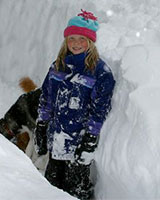Videos
|
Air. Planet. People.
|
NSF/NCAR C-130
|
|
NSF/NCAR C-130 Missed Appraoch for Research Purposes
|
K-12 SCIENCE EDUCATION MODULES
Teaching Boxes are themed collections of classroom-ready educational resources to build student understanding of science, technology, engineering, and math (STEM). Resources highlighted within teaching boxes are from various science education programs and all have been vetted by the education team at the UCAR Center for Science Education.
>> Learn more
 Winter weather may cancel school, but it’s also an opportunity to learn science. This teaching box is filled with hands-on activities that get primary grade students to learn the science of winter weather including concepts of earth science. Explore the educational resources in this teaching box and bring snow and ice into your classroom!
Winter weather may cancel school, but it’s also an opportunity to learn science. This teaching box is filled with hands-on activities that get primary grade students to learn the science of winter weather including concepts of earth science. Explore the educational resources in this teaching box and bring snow and ice into your classroom!
>> Learn more
 The troposphere is the lowest layer of Earth's atmosphere. Most of the mass (about 75-80%) of the atmosphere is in the troposphere. Most types of clouds are found in the troposphere, and almost all weather occurs within this layer.
The troposphere is the lowest layer of Earth's atmosphere. Most of the mass (about 75-80%) of the atmosphere is in the troposphere. Most types of clouds are found in the troposphere, and almost all weather occurs within this layer.
>> Learn more
Windows to the Universe :: Ozone
 Ozone is a special kind of oxygen molecule. Normal oxygen molecules (O2), the kind we need to breathe, have two oxygen atoms. Ozone molecules (O3) have three oxygen atoms. Ozone forms when a photon of ultraviolet (UV) "light" from the Sun strikes a normal oxygen molecule, breaking it apart. One of the atoms freed by this photodissociation process attaches itself to another oxygen molecule, converting it into ozone.
Ozone is a special kind of oxygen molecule. Normal oxygen molecules (O2), the kind we need to breathe, have two oxygen atoms. Ozone molecules (O3) have three oxygen atoms. Ozone forms when a photon of ultraviolet (UV) "light" from the Sun strikes a normal oxygen molecule, breaking it apart. One of the atoms freed by this photodissociation process attaches itself to another oxygen molecule, converting it into ozone.
>> Learn more
ADVANCED SCIENCE EDUCATION MODULES
UCAR MetEd :: Atmospheric Composition (free login required)
 The best-known application with the longest established contribution from satellites is stratospheric ozone monitoring. This continues to be important as we monitor the anticipated recovery of the ozone layer.
The best-known application with the longest established contribution from satellites is stratospheric ozone monitoring. This continues to be important as we monitor the anticipated recovery of the ozone layer.
>> Learn more
UCAR MetEd :: Winter Weather Distance Learning Course (free login required)
Winter weather presents many challenges to the forecaster. This self-paced, distance learning course addresses the scientific aspects of a few of those challenges: microphysics, precipitation type, precipitation amount, and applications of NWP ensembles.
>> Learn more
UCAR MetEd :: Weather and Health (free login required)
 This course will help meteorologists and others broaden their understanding of the impacts of weather and climate on public health, including the impacts of heat waves and cold temperatures, winter storms and thunderstorms, flooding, drought, poor air quality, tornadoes, hurricanes, wildfire, UV radiation, and others.
This course will help meteorologists and others broaden their understanding of the impacts of weather and climate on public health, including the impacts of heat waves and cold temperatures, winter storms and thunderstorms, flooding, drought, poor air quality, tornadoes, hurricanes, wildfire, UV radiation, and others.
>> Learn more
Dataset Documentation Requirements


